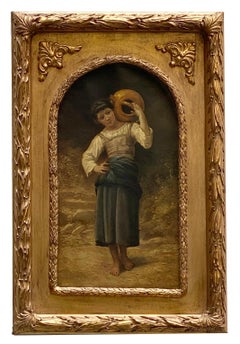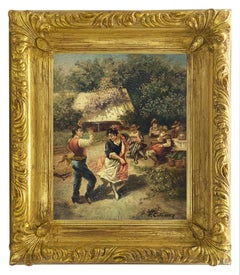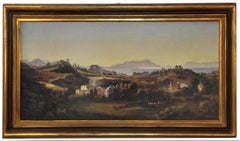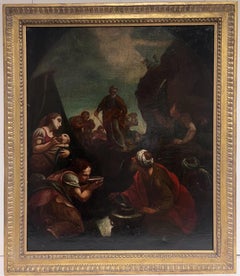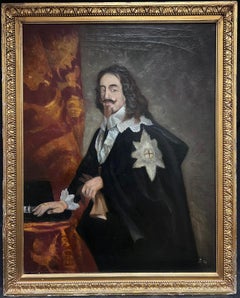Pietro Colonna Art
to
5
2
Overall Width
to
Overall Height
to
7
4
4
3
6
4
3
2
1
1
1
1
1
1
1
7
7
5
5
2
7
16
15
13
12
3
7
7
Artist: Pietro Colonna
Dealer: CAIAFA ARTE di MASSIMO CAIAFA
COUNTRY GIRL- W.A.Bouguereau- Italian Portarit of young peasant Oil on canvas
By Pietro Colonna
Located in Napoli, IT
Country girl - Pietro Colonna Italia 2006 - Oil on canvas cm. 45x25
Gold gilded wooden frame available on request
The painting by Pietro Colonna is a free interpretation of the paint...
Category
Early 2000s Old Masters Pietro Colonna Art
Materials
Canvas, Oil
COUNTRY SCENE - Italian School - Italy - Oil on canvas painting
By Pietro Colonna
Located in Napoli, IT
Country scene - Pietro Colonna Italia 2012 - Oil on canvas cm. 30x24
The painter Pietro Colonna depicts in this picture a cheerful and colorful peasant folk dance. The painting is in...
Category
Early 2000s Italian School Pietro Colonna Art
Materials
Canvas, Oil
LANDSCAPE - Italian School - Landescape - Oil on Canvas Painting
By Pietro Colonna
Located in Napoli, IT
Landscape - Pietro Colonna Italia 2007 - Oil on canvas cm. 30x60
It was Antonio Pitloo, a young Dutchman who arrived in Naples in 1815 after a stay in Paris, who led to the birth of ...
Category
Early 2000s French School Pietro Colonna Art
Materials
Canvas, Oil
COUNTRY GIRL- In the Manner of W.A.Bouguereau- Italy Oil on canvas -Painting
By Pietro Colonna
Located in Napoli, IT
Country girl - Pietro Colonna Italia 2006 - Oil on canvas cm. 45x25
Gold gilded wooden frame available on request
The painting by Pietro Colonna is a reinterpretation of the Young Sh...
Category
Early 2000s Old Masters Pietro Colonna Art
Materials
Canvas, Oil
COUNTRY SCENE -Italian School Landescape Rural- Italian Oil on canvas Painting
By Pietro Colonna
Located in Napoli, IT
Country scene - Pietro Colonna Italia 2008 - Oil on board cm. 30x40
Gold gilded wooden frame available on request
In this wonderful oil on panel the painter portrays some washerwomen as they are doing their work on the banks of a watercourse. In the background a rural landscape. The painting inspires...
Category
Early 2000s Old Masters Pietro Colonna Art
Materials
Oil, Board
COUNTRY SCENE -Neapolitan School - Italian Oil on canvas Painting.
By Pietro Colonna
Located in Napoli, IT
Country scene - Pietro Colonna Italia 2008 - Oil on board cm. 30x40
Gold gilded wooden frame available on request
Category
Early 2000s Old Masters Pietro Colonna Art
Materials
Oil, Board
SERENADE- Pietro Colonna - Italian Figurative Oil on canvas Painting
By Pietro Colonna
Located in Napoli, IT
Serenade - Pietro Colonna Italia 2005 - Oil on canvas cm. 60 x 30
The painting by Pietro Colonna depicts a romantic scene in which the young man plays the lute to his sweet girl, th...
Category
Early 2000s Romantic Pietro Colonna Art
Materials
Canvas, Oil
Related Items
17th Century Italian Old Master Oil Painting Moses Striking Water from the Rock
By Pier (Pietro) Dandini
Located in Cirencester, Gloucestershire
Moses Striking Water from the Rock;
Circle of Pietro Dandini, Italian 1646-1712
Italian School, late 17th century
oil on canvas, framed
framed: 3...
Category
Early 18th Century Old Masters Pietro Colonna Art
Materials
Canvas, Oil
King Charles 1st Antique Oil Painting Portrait of Famous British Monarch
Located in Cirencester, Gloucestershire
King Charles I
British artist, early 20th century
signed with initials
oil on canvas, framed
framed: 36 x 29 inches
canvas: 32 x 26 inches
provenance: p...
Category
Early 1900s Old Masters Pietro Colonna Art
Materials
Oil, Canvas
18th Century Oil on Canvas Portrait, Major Alexander Brown in Military Uniform.
By Sir David Wilkie
Located in Cotignac, FR
18th Century Military portrait of a young officer in Napoleonic period military dress. The painting is not signed but the subject is Major Alexander Brown. The work is oil on canvas later mounted on board and presented in a fine 'Regence style' carved gilt frame. There are labels to the back referring to the subject, 'Major Brown of Trinity' and a framers trade label from Edinburgh.
A magnificent and imposing portrait of a young military officer in the prime of his life. His red uniform adorned with fine buttons, fringed epaulettes and high gilt collar. His ruddy complexion offset by his stylish hair, a quiff and swept forward to the sides as was the fashion at the time.
Sir David Wilkie RA (18 November 1785 – 1 June 1841) was a Scottish painter, especially known for his portraits, including formal royal ones, and scenes from his travels to Europe and the Middle East. He painted successfully in a wide variety of genres, including historical scenes. His main base was in London, but he died and was buried at sea, off Gibraltar, returning from his first trip to the Middle East. He was sometimes known as the "people's painter".
He was Principal Painter in Ordinary to King William IV and Queen Victoria. Apart from royal portraits, his best-known painting today is probably The Chelsea Pensioners Reading the Waterloo Dispatch of 1822 in Apsley House.
Sir David Wilkie was actually admitted in 1799 (despite only being 14) through the influence of the Earl of Leven...
Category
Late 18th Century Old Masters Pietro Colonna Art
Materials
Canvas, Oil, Board
H 30.71 in W 25.6 in D 0.79 in
Huge Antique Dutch Old Master Oil Painting The Jewish Bridge after Rembrandt
Located in Cirencester, Gloucestershire
The Jewish Bridge
antique Dutch School, after the 1660's oil painting by Rembrandt (Rijksmuseum, Amsterdam)
oil painting on canvas, framed in its antique gilt frame with ornate mould...
Category
Late 19th Century Old Masters Pietro Colonna Art
Materials
Oil, Canvas
Huge Victorian English Old Master Oil Painting Madonna & Christ Child after Dyck
Located in Cirencester, Gloucestershire
The Madonna and Christ Child
English School, 19th century
after the earlier painting by Sir Anthony van Dyck
oil on canvas, framed in fine elaborate gilt frame.
Framed: 49 x 39.5 in...
Category
19th Century Old Masters Pietro Colonna Art
Materials
Oil, Canvas
17th century Flemish school, Madonna with child and red Drapery. Oil/wood
Located in Firenze, IT
Madonna with Child and Red Drapery, Flemish School, Oil on Oak Panel, 17th Century
Flemish School, 17th century
Technique: oil on oak panel with 4 crossbars
Dimensions: Height: 43...
Category
17th Century Old Masters Pietro Colonna Art
Materials
Wood, Oil, Wood Panel, Board
Fine 18th Century English Aristocratic Portrait of a Lady Oval Canvas Gilt Frame
Located in Cirencester, Gloucestershire
Artist/ School: English School, circa 1740's
Title: Portrait of a Lady, traditionally identified as 'Anne of Chesterfield'.
Medium: oil painting on canvas, framed
Size: painting: ...
Category
Early 18th Century Old Masters Pietro Colonna Art
Materials
Canvas, Oil
Robert T Stuart, River Landscape, Evening Mood
Located in Cheltenham, GB
This evocative mid-19th-century oil painting by Robert T Stuart (XIX) depicts a picturesque river landscape illuminated by a setting sun.
A silhouetted wood stands before a majestic...
Category
1860s French School Pietro Colonna Art
Materials
Canvas, Oil
Oval 18th century Portrait of a Young girl, oil on copper
By (Follower of) Sir Godfrey Kneller
Located in Woodbury, CT
This exquisite 18th-century portrait depicts a young girl, delicately rendered in the style of Sir Godfrey Kneller, one of the most celebrated portrait painters of the Baroque period...
Category
1750s Old Masters Pietro Colonna Art
Materials
Copper
Man Holding a Jug (The Sense of Taste)
Located in Stockholm, SE
This evocative 19th-century painting is the work of a follower of the Dutch Golden Age artist Jacob Toorenvliet, known for his finely rendered genre scenes. Titled Man Holding a Jug ...
Category
Early 19th Century Old Masters Pietro Colonna Art
Materials
Canvas, Oil, Board
Fine Italian Old Master Oil Painting Angel & Saints Appearing to Figures
Located in Cirencester, Gloucestershire
Artist/ School: Italian Old Master, 18th century
Title: Angel and Saints appearing to figures, one dressed in a white ruff collar.
Medium: oil on canvas...
Category
Early 18th Century Old Masters Pietro Colonna Art
Materials
Canvas, Oil
Portrait of Lady Caroline Price
By George Romney
Located in Miami, FL
DESCRIPTION: Perhaps the best Romney in private hands. If Vogue Magazine existed in the late 18th century, this image of Lady Caroline Price would be ...
Category
1970s Old Masters Pietro Colonna Art
Materials
Oil, Canvas
Pietro Colonna art for sale on 1stDibs.
Find a wide variety of authentic Pietro Colonna art available for sale on 1stDibs. You can also browse by medium to find art by Pietro Colonna in oil paint, paint, canvas and more. Much of the original work by this artist or collective was created during the 21st century and contemporary and is mostly associated with the Old Masters style. Not every interior allows for large Pietro Colonna art, so small editions measuring 10 inches across are available. Customers who are interested in this artist might also find the work of Antonio Savisio, Giulio Di Sotto, and Matthew Cook. Pietro Colonna art prices can differ depending upon medium, time period and other attributes. On 1stDibs, the price for these items starts at $1,460 and tops out at $2,745, while the average work can sell for $2,053.
